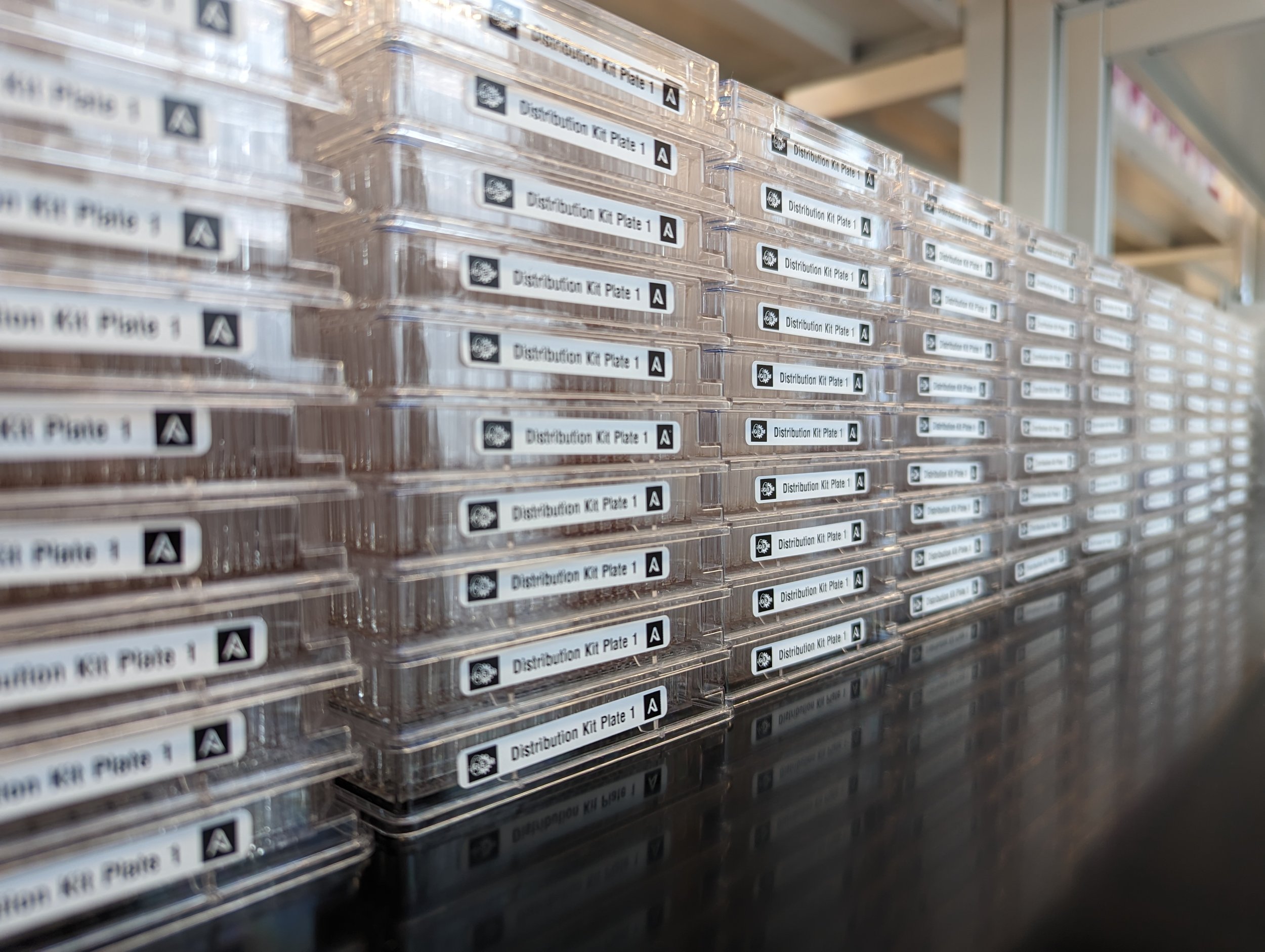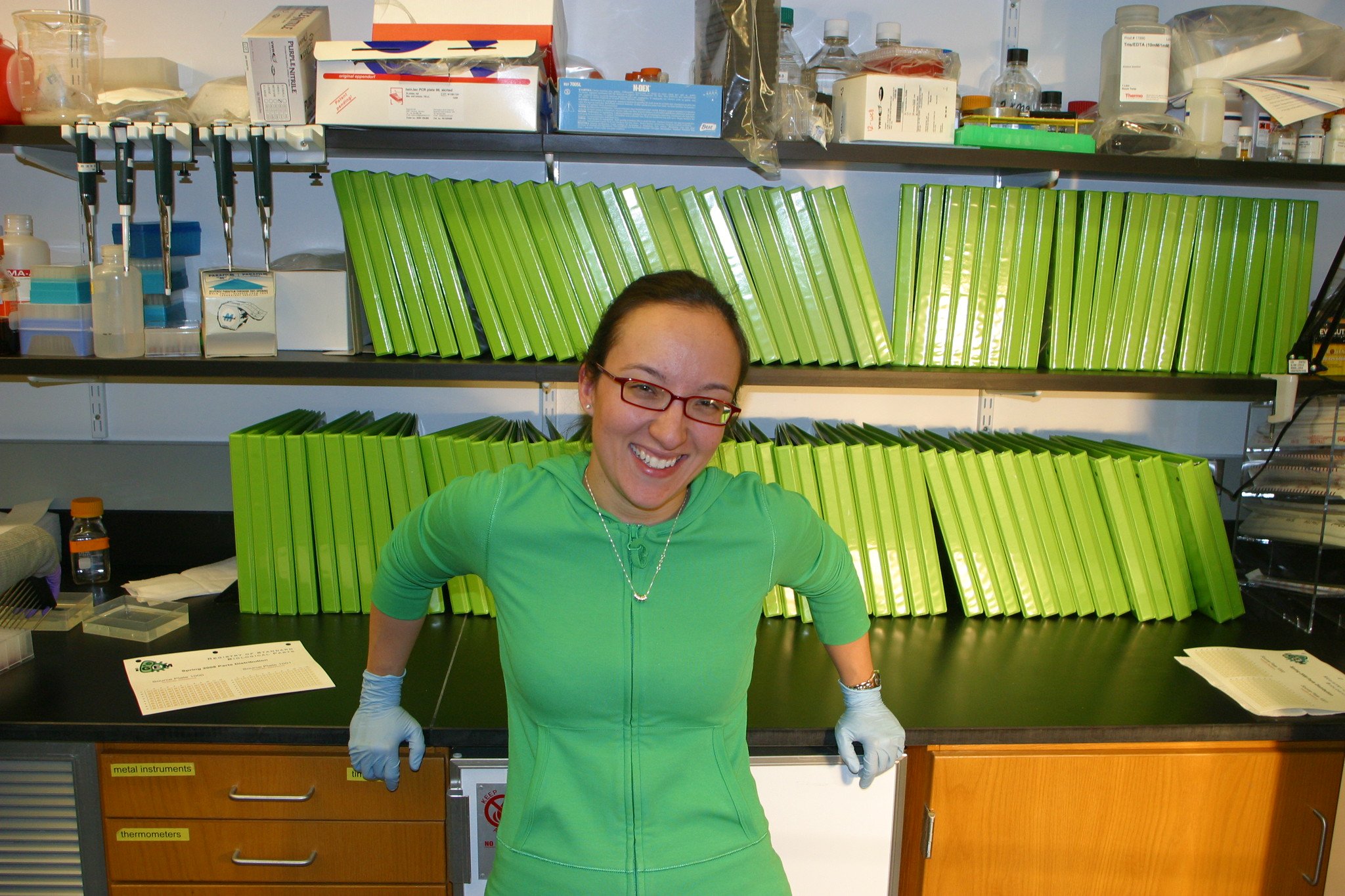A Look Back on the History of the iGEM Distribution
by Vinoo Selvarajah, Abigail Sison, and Linda Kahl
DNA Day (April 25) is just around the corner. As you can imagine, DNA is a rather big deal at iGEM. In just a few short weeks, the 2023 iGEM Distribution kit - containing hundreds of physical DNA parts - will be sent in the mail to teams all around the world.
Take a moment to consider what it means to have a curated collection of DNA parts from iGEM’s entire 20-year history arriving in your mailbox!
When you open the package, you will be holding the ingenuity of all of the iGEM teams since 2003 that have designed parts for new areas of investigation, built upon each other’s work to refine parts, and tested the performance of parts as they’ve explored new technologies.
The iGEM Distribution is not just sample sharing, it’s a physical artifact that embodies iGEM’s Get, Give (& Share) philosophy. At the beginning of an iGEM Competition season, each team will ‘Get’ the Distribution that they can use to create biological systems to tackle everyday issues facing the world. At the end of the iGEM Competition season, the teams then ‘Give’ the new and refined parts they’ve created, and ‘Share’ their knowledge about how the parts performed in their system.
The iGEM Distribution is not just sample sharing, it’s a physical artifact that embodies iGEM’s Get, Give (& Share) philosophy.
When the iGEM Distribution arrives in your mailbox, you and your teammates will be the beneficiaries of (and soon-to-be contributors to) iGEM’s legacy. Thanks to our partnership with Asimov, this year’s Distribution is being made using the highest quality manufacturing process to date – from its design as a process, to the use of automation and quality control.
Over the past 20 years, many people and organizations have supported the iGEM Distribution. In this post, we’d like to take a look back on the history of the iGEM Distribution and how it has evolved over time. But first, you may be wondering…
“Why, in a time when DNA synthesis is possible, does it make sense to physically distribute a collection of parts?”
There are a number of reasons that are as valid today as they were when iGEM was just getting started:
Large Library
It’s useful to have a large library of parts that work together and is widely shared. The more people who work with and characterize parts, improve upon existing parts and create new parts, the better and more useful the library becomes for everyone.
Access
Twenty years ago, not everyone had access to DNA synthesis. Although DNA synthesis technologies have improved and become more widely available, access to DNA synthesis remains an issue, particularly in areas where synthetic biology ecosystems are still in their infancy.
Symbolic
Having a physical collection of parts that is iteratively refined and distributed each year to teams around the world is symbolic of an open community.
Limited Budgets
A physical collection of parts reduces the need for DNA synthesis, so that money that might otherwise be spent on DNA synthesis can be spent elsewhere.
Phase 1:
The very beginning (2003 – 2008)
Back in 2003, when that fateful MIT course that gave rise to iGEM was taking place, the question was “Can you build simple biological systems out of interchangeable parts?” That year, the students did not receive a collection of parts for their project, but instead focused on designing parts that were then synthesized for them by the DNA synthesis company, Blue Heron. The parts the students had synthesized in 2003 became part of the iGEM Distribution, but there’s more to the story …
Tom Knight, an iGEM founder and one of the teachers of the 2003 MIT course, had developed the BioBrick assembly standard. In 2002, he distributed a collection of 12 Biobrick-compatible parts under a grant from US Defense Advanced Research Projects Agency (DARPA) to about 30 people at a DARPA meeting. This collection of 12 parts in the DARPA Distribution of 2002 were included in the first iGEM Distribution.
Did you know?
There is a copy of the 2002 DARPA Distribution, as well as some early iGEM Distribution kits, on deposit at the London Science Museum, along with Tom’s lab notebook pages.
Distributions grew quickly in size (from 200-300 parts in 2004 to more than 1700 parts in 2008)
The first iGEM Distribution happened in 2004, under a Get & Give (& Share) policy to create an open, collaborative community of synthetic biologists. The idea was that teams would get the Distribution, use the existing parts and make new parts for their projects, then give back by documenting their new parts on the Registry and sending samples to be incorporated into the Registry’s sample repository so that future teams could use and build upon their work.
Some interesting facts about the iGEM Distribution during these early years:
The first iGEM Distribution contained many essential parts that are still used today: BBa_B0032, BBa_R0040, BBa_B0015 all have been used by thousands of iGEMers for hundreds of different projects.
Distributions grew quickly in size (from 200-300 parts in 2004 to more than 1700 parts in 2008), and included almost every sample in the iGEM Registry’s sample repository.
The technologies used to create and send the Distributions evolved over time – from 96-well plates (2004), to 384-well plates (2005-7), to filter paper stamped in a 96-well format (2008).
In 2008, the distribution used filter paper stamped with samples in a 96-well format.
Filter paper distribution kits were mailed to teams in binders in 2008.
Phase 2:
Focus on quality (2009 – 2021)
iGEM’s Distribution Kit is made using an iterative process.
From 2009 onwards, we focused on improving the quality of the Distribution (2009 was also the year I joined iGEM). Instead of distributing every part that all teams sent to the iGEM Registry sample repository, we selected parts created by teams with award winning projects and distributed only those parts that we sequence confirmed by Sanger sequencing.
Throughout this phase, we provided additional kit components, to make life easier (linearized plasmid backbones), to better troubleshoot (competent cell test kit), and to test and encourage standard characterization protocols (Interlab Measurement Kit).
Linear plasmid backbones were included in the Distribution starting in 2010 to allow for easier assemblies and enable teams to provide their sample submissions in pSB1C3 (the shipping standard until 2018).
Transformation efficiency / competent cell test kits were included starting in 2013 to help teams determine where issues related to transformation might be coming from.
Parts submission kits, consisting of standard protocols and materials (96 well plates, shipping box, and foils) were included starting in 2015 to make it easier for teams to physically submit samples.
InterLab Device / Measurement kits were included in the 2016-19 Distributions so that teams could participate in the InterLab studies without the extra burden of building devices for those studies.
Packing distribution kits at our headquarters in Boston.
iGEM HQ (Boston) shipping kits to China in 2018, with thanks to our shipping partner GenScript.
We also worked with partners so that iGEM teams could live in the future. With reliable access to DNA synthesis, teams could focus more on designing and characterizing quality parts.
In 2015, IDT began offering teams 20 kb of DNA synthesis.
In 2016, iGEM partnered with Gen9 to synthesize over 300 constructs, consisting of highly used, requested, and/or characterized parts that had not yet been sequence confirmed.
Beginning in 2019, thanks to the generosity of iGEM partners IDT and Twist Bioscience, teams were no longer required to submit physical samples for the Registry’s repository.
After the 2021 Distribution, iGEM closed down the laboratory and began the transition to phase 3.
Phase 3:
Collaborative design, curation, and manufacturing (2022 – present)
Now that iGEM teams are living in the future with DNA synthesis, it is time to reconsider the purpose of the Distribution and the needs of iGEM teams. We expect the iGEM Distribution will continue to evolve as we move through this third phase, and we are contemplating multiple possibilities for the Distribution moving forward.
In preparation for 2022, we collaboratively designed the entire Distribution from the ground-up:
Multiple contributors from the iGEM Engineering Committee put together collections of useful parts.
Parts in the 2022 Distribution were synthesized by iGEM partner Twist Bioscience.
We collaborated with FreeGenes, including their most popular parts collections and using their space to manufacture the 2022 Distribution.
We are building on last year’s work to manufacture the 2023 Distribution for iGEM teams in partnership with Asimov. In addition to the curated, synthesized parts from the 2022 Distribution, the 2023 Distribution will also include a Mammalian parts collection, consisting of over 20 parts. Importantly, this year’s Distribution was manufactured at Asimov, bringing in best manufacturing practices, new automation workflows, and high quality control check points. Asimov will have more to share about their platform and process later this year.
If you are interested in contributing to the future of the iGEM Distribution, please consider joining the iGEM Engineering Committee. For details, about the committee, including how to apply, please see here: https://technology.igem.org/engineering-committee
















